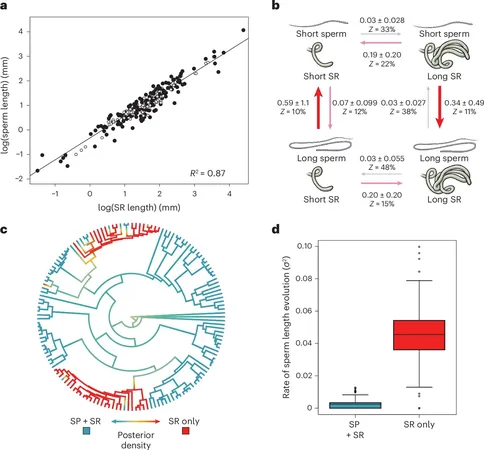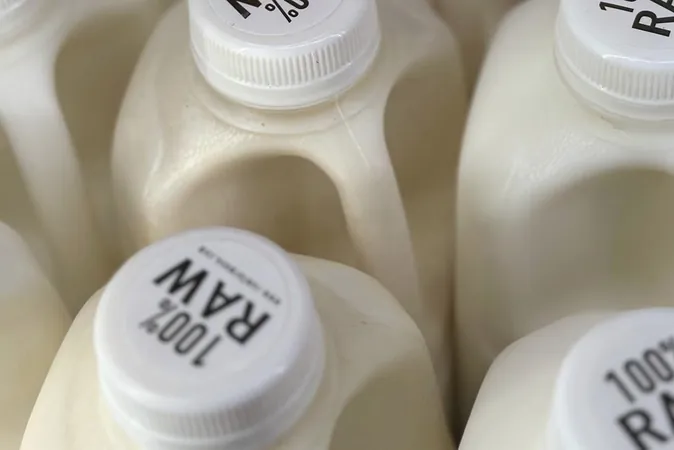
Unraveling the Mysteries of Sperm Evolution: Insights from Fruit Fly Research
2024-11-26
Author: Emma
Introduction
Sperm cells are renowned as one of the most diverse and rapidly changing cell types in the animal kingdom. Yet, the reasons behind their dramatic evolution remain a puzzle for scientists, continuing to intrigue biologists for over a century.
Research Overview
In an effort to crack this evolutionary enigma, researchers at Syracuse University's Center for Reproductive Evolution (CRE) have dedicated decades to investigating the mating biology of fruit flies, insects that may seem ordinary but are hiding a remarkable reproductive secret: exceptionally large sperm.
Sperm Length in Fruit Flies
Fruit flies exhibit an astonishing range of sperm lengths, surpassing the diversity seen in the entire animal kingdom combined. Notably, males of the species *Drosophila bifurca* are known to inseminate their partners with a mere handful of sperm, each measuring an incredible 5.8 cm in length—approximately 20 times longer than the female's body—rolled up tightly like a ball of yarn.
Role of Sexual Selection
The research team at CRE, led by esteemed biologists including Weeden Professor Scott Pitnick, Professor Steve Dorus, and Assistant Professor Yasir Ahmed-Braimah, has discovered that longer sperm have been favored through sexual selection, a concept first theorized by Charles Darwin in his 1871 work, "The Descent of Man and Selection in Relation to Sex." Essentially, the lengthy tails of sperm are better equipped to navigate the female reproductive tract, which is preferentially structured to favor the fertilization efforts of longer sperm.
Comparison with Other Natural Displays
This phenomenon positions long sperm tails as the post-mating equivalent of peacock feathers in the epic struggle for reproductive success. Previous research published in *Nature* from the Center for Reproductive Evolution has illustrated that the tails of fruit fly sperm can rival the most impressive displays seen in nature, such as the extravagant plumage of pheasants, the antlers of deer, and the intimidating horns of dung beetles.
Genetic Foundations of Sperm Evolution
However, understanding the genetic foundation of these traits has proven difficult, thus restricting the ability to test the existing theories of sexual selection and hypothesize new avenues for the evolution of sexual characteristics.
Pioneering Study
In a pioneering study recently published in *Nature Ecology & Evolution*, researchers from CRE collaborated with scientists from esteemed institutions including Stanford University, Cornell University, Virginia Tech, and the University of Zurich to illuminate the genetics surrounding the length of fruit fly sperm and the complexity of the female reproductive tract responsible for its evolution.
Research Methodology
The research involved analyzing the sperm lengths and the anatomical characteristics of the female seminal receptacle (SR)—essentially the female's mechanism of choosing sperm—across 149 fruit fly species. Following extensive genome sequencing from their earlier research, published in *PLOS Biology*, the team meticulously mapped these traits onto the fruit fly phylogenetic tree. This analysis revealed the intricate coevolution of these male and female traits over approximately 65 million years.
Genome-Wide Association Study
Employing a genome-wide association study, the team identified potential genes that contributed to variations in both sperm and SR lengths within the lab model *Drosophila melanogaster*. Surprisingly, only 19% of the genes affecting sperm length exhibited biased expression in testes, traditionally associated with sperm production. Interestingly, many of these implicated genes also play key roles in the development and functioning of the nervous system, and are linked to vision and smell. Additionally, the genetic variation in sperm length was found to correlate with vital reproductive features such as female fecundity and the ability to survive periods of starvation.
Implications of the Findings
These findings suggest that the evolution of female reproductive tracts favoring males with longer sperm allows females to 'shop' for advantageous genetic traits—those that can enhance survival and increase reproductive success in their offspring.
Computational Insights
Utilizing a sophisticated algorithm and approximately 15 million hours of computing power from Syracuse University's OrangeGrid computing network, the researchers identified genes whose rates of evolutionary change correlate significantly with the evolution of both sperm and SR length across species. This comprehensive approach reaffirmed the genetic link between sperm length and the development of the nervous system.
Broader Significance
The implications of this study extend beyond fruit flies, potentially reshaping our understanding of sexual selection and mate preferences across the animal kingdom. Scientists are optimistic that these insights could lay the groundwork for further exploration into how reproductive traits evolve in various species, making this research groundbreaking in the field of evolutionary biology.
Conclusion
Stay tuned as we continue to monitor these developments in reproductive biology; who knows what exciting discoveries lie ahead?









 Brasil (PT)
Brasil (PT)
 Canada (EN)
Canada (EN)
 Chile (ES)
Chile (ES)
 España (ES)
España (ES)
 France (FR)
France (FR)
 Hong Kong (EN)
Hong Kong (EN)
 Italia (IT)
Italia (IT)
 日本 (JA)
日本 (JA)
 Magyarország (HU)
Magyarország (HU)
 Norge (NO)
Norge (NO)
 Polska (PL)
Polska (PL)
 Schweiz (DE)
Schweiz (DE)
 Singapore (EN)
Singapore (EN)
 Sverige (SV)
Sverige (SV)
 Suomi (FI)
Suomi (FI)
 Türkiye (TR)
Türkiye (TR)